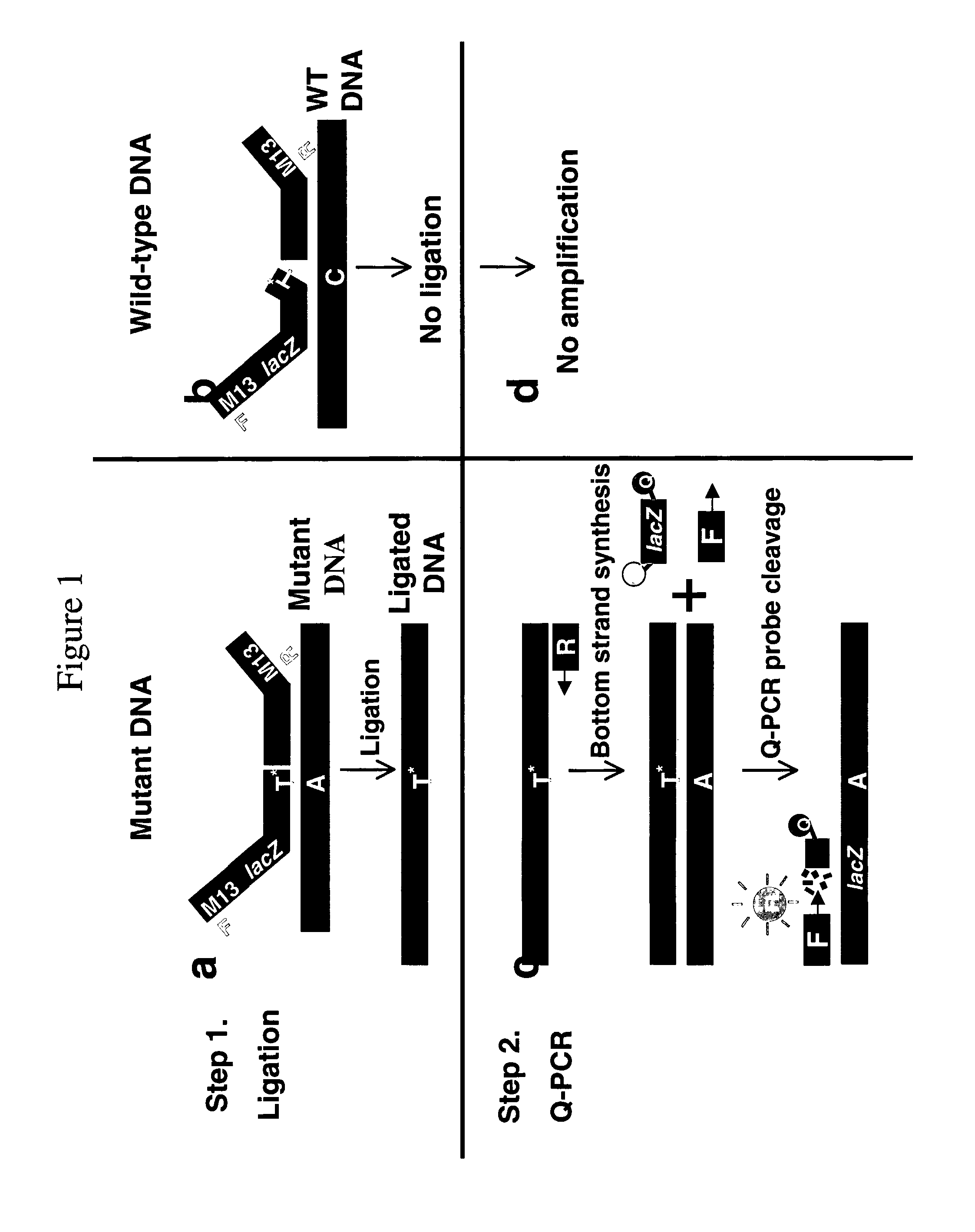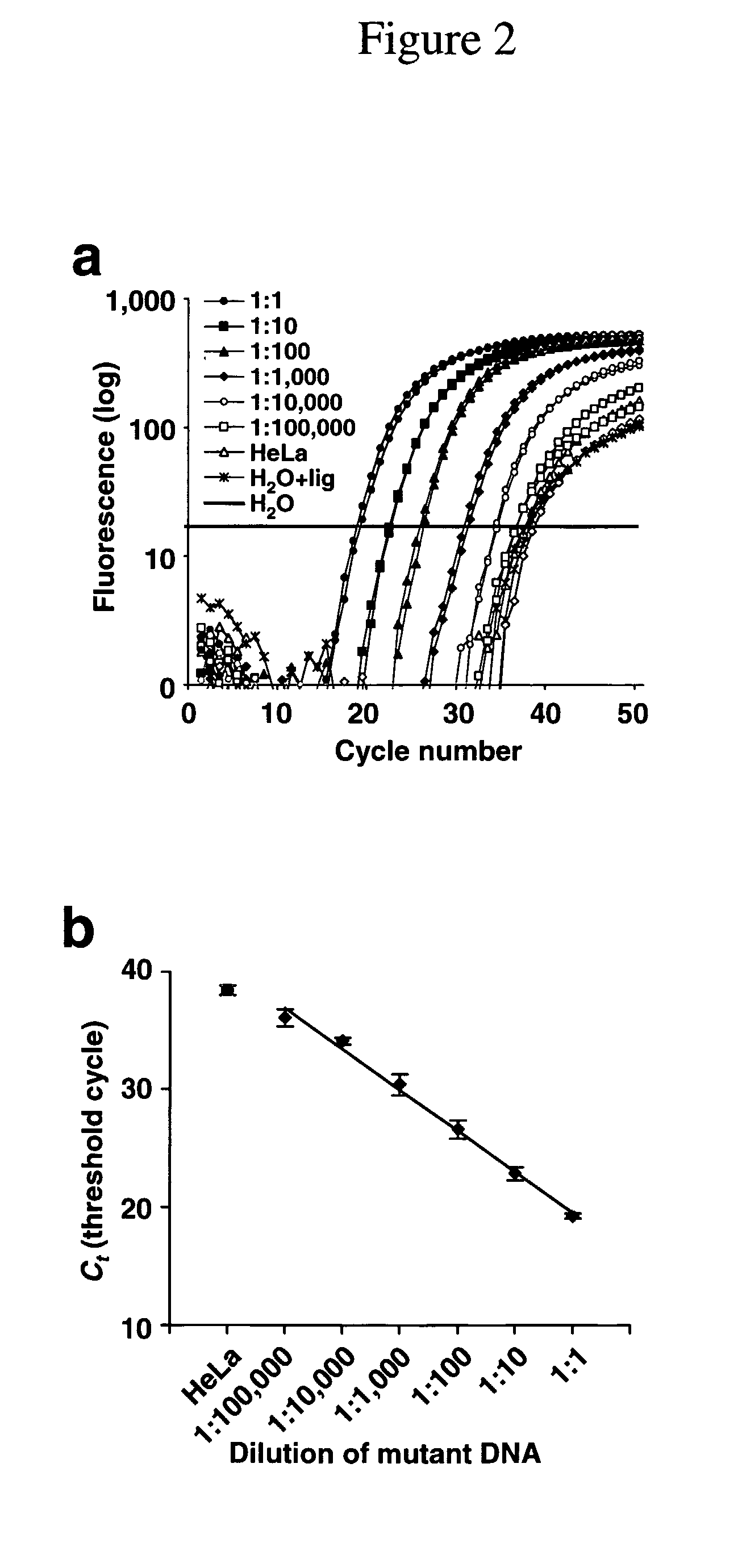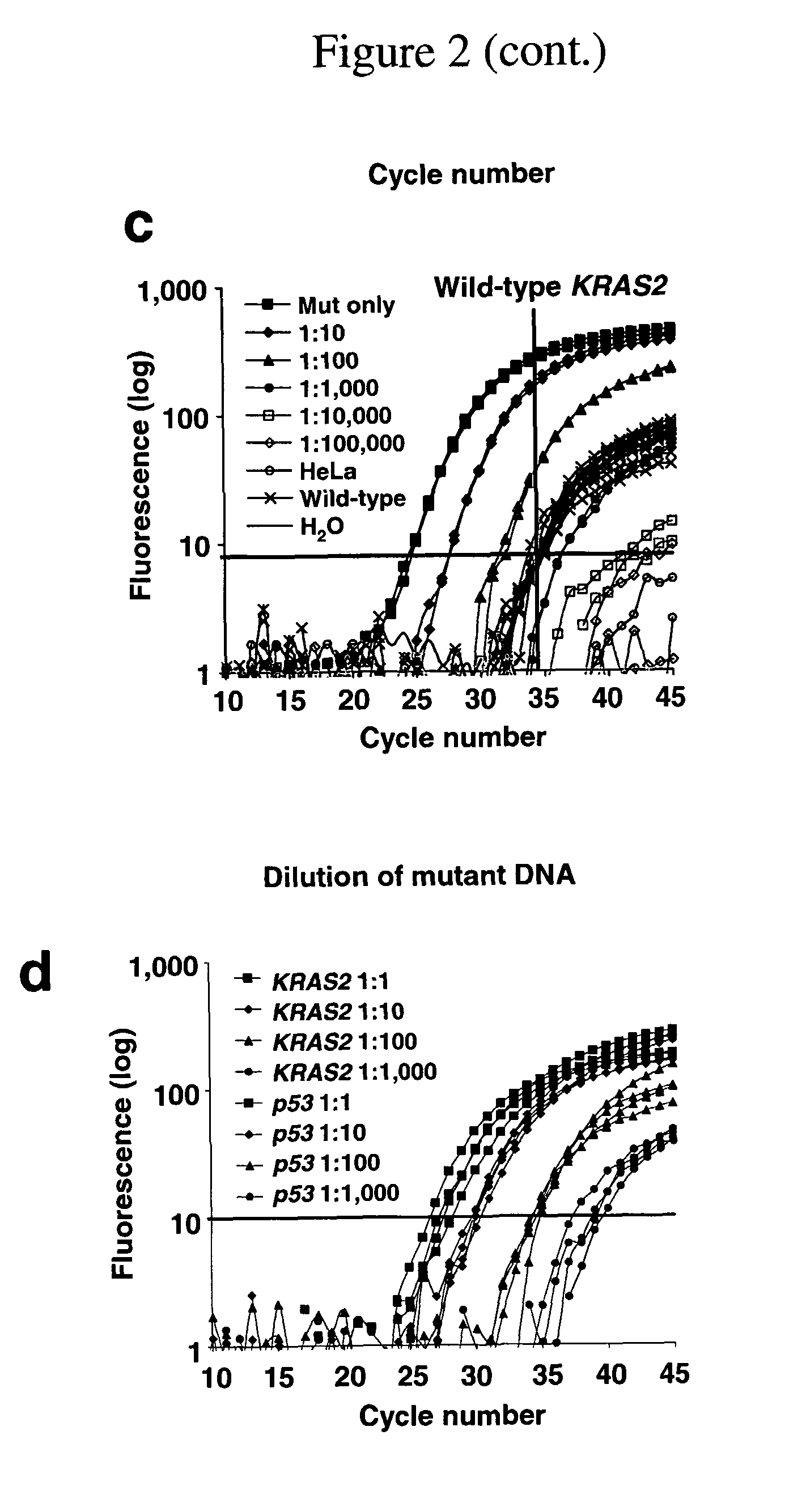Methods for the detection of nucleic acid differences
a nucleic acid and difference technology, applied in the field of nucleic acid differences detection methods, can solve the problems of difficult application to the detection of point mutations, lack of accurate quantification techniques, and development of sensitive and accurate methods for point mutation detection, etc., and achieve the effect of high selectivity
- Summary
- Abstract
- Description
- Claims
- Application Information
AI Technical Summary
Problems solved by technology
Method used
Image
Examples
example 1
Genomic DNA Isolation
[0244]Genomic DNA was isolated using the DNeasy Tissue Kit (Qiagen, Valencia, Calif.) (Fukushima, N. Et al. Diagnosing pancreatic cancer using methylation specific PCR analysis of pancreatic juice. Cancer Biol Ther 2, 78-83 (2003)).
KRAS2 Sequencing
[0245]We PCR amplified the KRAS2 locus using M13-tailed primers (5′-GTAAAACGACGGCCAGG-GAGAGAGGCCTGCTGAAAA-3′ (SEQ ID NO: 1) and 5′-CAGGAAACAGCTATGACT-TGGATCATATTCGTCCACA-3′ (SEQ ID NO: 2), M13 tails underlined). M13 primers were used for sequencing, the BigDye Terminator 3.1 Cycle Sequencing Kit and an ABI Prism 3100 Genetic Analyzer (Applied Biosystems, Foster City, Calif.).
Population Sequencing of Plasma HIV-1
[0246]We sequenced plasma samples diluted at 100,000 copies / ml HIV-1 RNA (using plasma from an individual without HIV-1 infection) with the ViroSeq™ HIV-1 Genotyping System (Celera Diagnostics, Alameda, Calif.). Using this system, HIV-1 RNA was extracted and reverse transcribed. A 40-cycle PCR yields a 1.8 kb PC...
example 2
DNA Extraction
[0265]Genomic DNA was prepared from Hela (KRAS2 wild-type, GGT), SW480 (GTT) and LS513 (GAT) cell lines and the formalin-fixed, paraffin embedded pancreatic cancer blocks using QiAamp DNeasy Tissue Kit (Qiagen, Valencia, Calif.). All patients in this study were operative candidates (Whipple procedure) and the pancreatic duct juice samples were collected intra-operatively and genomic DNA isolated using the QIAamp DNA Blood Mini Kit (Qiagen).
KRAS2 Sequencing
[0266]KRAS2 sequencing was performed on pancreatic cancer DNA by PCR amplifying the KRAS2 locus (including codon 12) using the upstream 5′-GTAAAACGACGGCCAGG-GAGAGAGGCCTGCTGAAAA-3′ (SEQ ID NO: 1) and downstream 5′-CAGGAAACAGCTATGACT-TGGATCATATTCGTCCACA-3′ (SEQ ID NO: 2) M13 tailed (underlined regions) primers. Sequencing was then performed using M13 forward or reverse primers, BigDye 3.1 and a 3100 capillary sequencer (ABI, Applied Biosystems (Foster City, Calif.).
LigAmp Oligonucleotides and Probes
[0267]Ligation oligon...
example 3
Bile Duct Cancer Early Detection-Bile and Serum Analysis
[0290]LigAmp of KRAS2 mutation on bile and serum collected from patients with biliary cancer. Many patients with biliary tract carcinoma were diagnosed at an advanced stage, resulting a poor prognosis. Early detection of biliary cancer might improve the survival rate. Analysis of cancer-related genes present in bile or serum may provide a tool for early diagnosis. The genetic alterations such KRAS2 and p53 mutations were observed in sporadic biliary tract cancer.
[0291]DNA isolated from cancer tissues, bile and serum were first subjected to PCR amplification. Five hundred picogram PCR DNA was used as template for LigAmp. LigAmp on DNA from the biliary cancer tissues demonstrated that majority of cancer (more than 90%) harbored GAT mutation. Mutation of KRAS2 (GAT) was detected in 81% ( 13 / 16) of bile from patient with biliary cancer, while 21% ( 6 / 28) of bile from control group. These six control patients with KRAS2 mutation car...
PUM
| Property | Measurement | Unit |
|---|---|---|
| threshold | aaaaa | aaaaa |
| threshold | aaaaa | aaaaa |
| cycle threshold | aaaaa | aaaaa |
Abstract
Description
Claims
Application Information
 Login to View More
Login to View More - R&D
- Intellectual Property
- Life Sciences
- Materials
- Tech Scout
- Unparalleled Data Quality
- Higher Quality Content
- 60% Fewer Hallucinations
Browse by: Latest US Patents, China's latest patents, Technical Efficacy Thesaurus, Application Domain, Technology Topic, Popular Technical Reports.
© 2025 PatSnap. All rights reserved.Legal|Privacy policy|Modern Slavery Act Transparency Statement|Sitemap|About US| Contact US: help@patsnap.com



